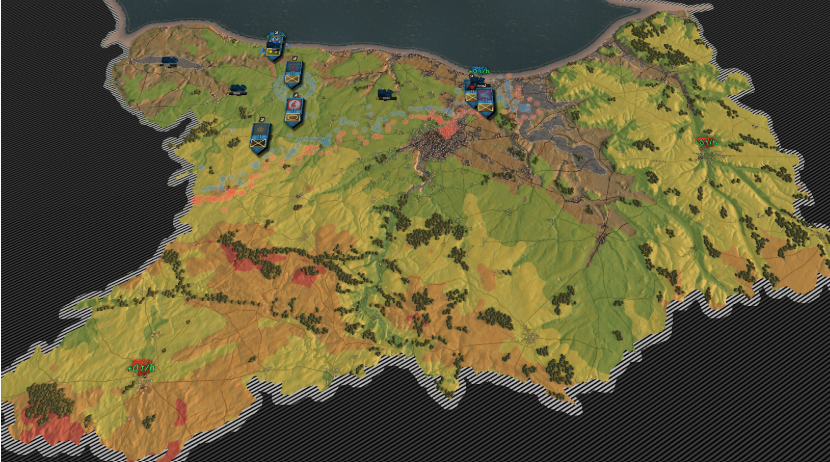Welcome to the Battleplan developer diaries! We’ll cover various topics to help you understand the game better and give you an edge against the enemy! Today we’ll cover defence – holding territory and vital landmarks.
POSITION UNITS DURING DEPLOYMENT
Planning your defence starts before the mission does! In the deployment phase you can position your units anywhere in friendly territory. Your units instantly gain fortifications when the mission starts, so position your units during deployment, rather than moving them AFTER the mission starts.
TERRAIN
Terrain alters the stats of units sitting inside it. Towns & forests are defensive terrain, increasing defence and firepower, whilst decreasing movement speed. Position your units at the edges of forests and towns, so enemies have to approach through the open.

Swamps, wetlands and beaches are all-around terrain. They lower defence, firepower, movement speed and morale drastically. Avoid putting your units there, and force the enemy to move through them instead!
ELEVATION
Click the ‘Elevation’ view toggle to see real-world elevation of the area. Units on high ground can see further downhill, letting you see the enemy further away. Elevation also confers firepower and defence bonuses. Try to position units above the enemy, though this isn’t always possible since the Allies are mainly on the offence.

KNOW WHEN TO GIVE UP TERRITORY
Just because you start with a large amount of territory, doesn’t mean you need to keep it. Often you have too few troops to properly defend the entirety of the frontline. It can be better to give up ground, and defend a narrower front or hold more favourable terrain.

Looking at Caen, the airborne troops start in terrible swamps. This makes attacking from there miserable. Consider pulling them back across the river, narrowing your frontage and allowing your frontlines to be thicker.
FORTIFICATIONS & MINEFIELDS
Units automatically dig fortifications when stationary. Most units can dig minor fortifications, whilst engineers can dig more effective fortifications. Fortifications appear visually on the map (trenches, foxholes) and change based on their effectiveness. Some scenarios have pre-build fortifications (bunkers & tank traps) which are very effective.

Mousing over a fortified unit shows their fortification level/percentage near the mouse, and more stats in the stats panel. Fortifications provide defence whilst also increasing firepower. During combat fortifications are degraded (and are rapidly degraded by planned artillery barrages & aerial bombing). Fortified units are hard to damage until their fortifications are destroyed.
Engineers automatically lay minefields (seen visually as red skull signs and small, gray round mines). Units moving in minefields take damage, and have lower defence, firepower, speed and morale. You can give an explicit ‘Lay Minefield’ order if you want certain intersections or roads mined, or just let engineers to it automatically. When units are in minefields, they’ll call friendly engineers to clear the mines which removes the combat penalties when moving through minefields.
FRONTLINE & RESERVES
Defending everything is the same as defending nothing. -Sun Tzu, probably.
You often don’t have enough troops to properly defend the ENTIRE frontline. If a panzer division attacks, it will breakthrough most frontlines with ease. You can’t know where the break through can occur, so how can you defend against this? Have reserves.

Have a thinly spread frontline of infantry to prevent the enemy from cautiously advancing. Then place your armour divisions a few kilometers behind the frontline using the ‘Reserves’ or ‘Counterattack’ orders. Reserve formations should sit in front of/on top of supply depots to protect them. They should also be placed along roads leading towards objectives you MUST hold (ex: Bayeux in the Caen mission).

When a panzer division attacks it WILL pierce your thin frontline, however your armoured units should quickly arrive and stop a deep penetration. If the enemy moves too quickly and doesn’t leave any rear-security, your broken infantry frontline may reform and cut them off from behind (cutting them off from supply, applying debuffs).
Use the ‘Complex Defence’ order to have a single division split itself up with several regiments defending the frontline, and one regiment in reserve.

INFANTRY & ARMOUR ON DEFENCE
Infantry gains more bonuses from fortifications. They’re also more plentiful and move more slowly. Use them on the frontlines.
Armour and mechanized infantry on the otherhand receive fewer bonuses from fortifications, and move quickly. They’re also far more valuable on the offence, so try to limit their losses. Use them as elite reserves that rush to plug any gaps.
TRUST AUTO-PLACEMENT
Your forces are deployed automatically at mission start, and will follow the above doctrine: thin infantry frontlines, armour on counterattacks. If you’re new, just stick with this deployment! Trust your officers know what they’re doing.

SUPPLY DEPOT PLACEMENT
We’ll cover supply more in-depth in a later article, but suffice to say units need supply (ammo, food & fuel). If your frontline is thin, placing a depot nearby is risky since you won’t be able to prevent a determined breakthrough.
If your frontline is short/thick, or you have a reserve unit, place a supply depot on top of or nearby to maximize supply flow (the shorter path the faster supplies are transferred).
Now you know the basics of defence. Apply the above advice to limit your casualties, whilst inflicting maximum casualties on an attacker.
See you at the front, General!
Join on Discord
Wishlist now














